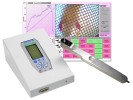Authors
M. Vivó, A. Puigdemasa, L. Casals, E. Asensio, E. Udina et al.
Lab
Department of Cell Biology, Physiology and Immunology, Group of Neuroplasticity and Regeneration, Institute of Neurosciences, Universitat Autònoma de Barcelona, Bellaterra, Spain.
Journal
Experimental Neurology
Abstract
We have studied whether electrical stimulation immediately after nerve injury may enhance axonal regeneration and modulate plastic changes at the spinal cord level underlying the appearance of hyperreflexia. Two groups of adult rats were subjected to sciatic nerve section followed by suture repair. One group (ES) received electrical stimulation (3 V, 0.1 ms at 20 Hz) for 1 h after injury. A second group served as control (C). Nerve conduction, H reflex, motor evoked potentials, and algesimetry tests were performed at 1, 3, 5, 7 and 9 weeks after surgery, to assess muscle reinnervation and changes in excitability of spinal cord circuitry. The electrophysiological results showed higher levels of reinnervation, and histological results a significantly higher number of regenerated myelinated fibers in the distal tibial nerve in group ES in comparison with group C. The monosynaptic H reflex was facilitated in the injured limb, to a higher degree in group C than in group ES. The amplitudes of motor evoked potentials were similar in both groups, although the MEP/M ratio was increased in group C compared to group ES, indicating mild central motor hyperexcitability. Immunohistochemical labeling of sensory afferents in the spinal cord dorsal horn showed prevention of the reduction in expression of substance P at one month postlesion in group ES. In conclusion, brief electrical stimulation applied after sciatic nerve injury promotes axonal regeneration over a long distance and reduces facilitation of spinal motor responses.
BIOSEB Instruments Used:
Electronic Von Frey 4 (BIO-EVF4),Electronic Von Frey 5 with embedded camera (BIO-EVF5)

 Pain - Thermal Allodynia / Hyperalgesia
Pain - Thermal Allodynia / Hyperalgesia Pain - Spontaneous Pain - Postural Deficit
Pain - Spontaneous Pain - Postural Deficit Pain - Mechanical Allodynia / Hyperalgesia
Pain - Mechanical Allodynia / Hyperalgesia Learning/Memory - Attention - Addiction
Learning/Memory - Attention - Addiction Physiology & Respiratory Research
Physiology & Respiratory Research
 Pain
Pain Central Nervous System (CNS)
Central Nervous System (CNS) Neurodegeneration
Neurodegeneration Sensory system
Sensory system Motor control
Motor control Mood Disorders
Mood Disorders Other disorders
Other disorders Muscular system
Muscular system Joints
Joints Metabolism
Metabolism Cross-disciplinary subjects
Cross-disciplinary subjects Happy new year 2025
Happy new year 2025 
